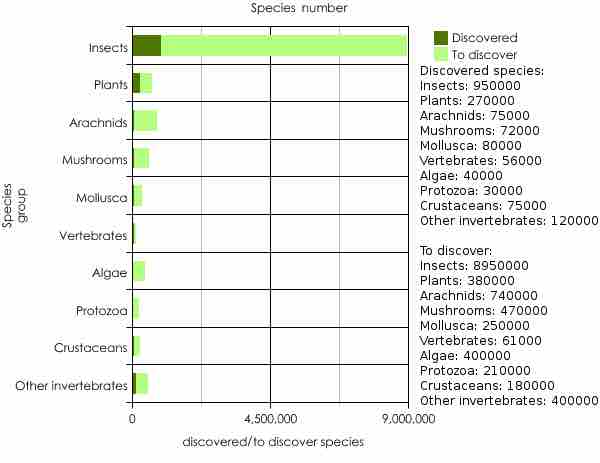According to the Global Taxonomy Initiative and the European Distributed Institute of Taxonomy, the total number of species for some phyla may be much higher than what was known in 2010:10–30 million insects; (of some 0.9 million we know today) 5–10 million bacteria; 1.5 million fungi; of some 0.075 million we know today . The number of microbial species is not reliably known, but the Global Ocean Sampling Expedition dramatically increased the estimates of genetic diversity by identifying an enormous number of new genes from near-surface plankton samples at various marine locations.

Known and Unknown Species
This graph shows how many species discovered (dark green) versus estimated species remaining to be discovered. This does not include many microscopic eukaryotic groups.
From these studies, it is apparent that less than 1% of all species that have been described have been studied beyond simply noting their existence. The vast majority of Earth's species are microbial. Contemporary biodiversity is "firmly fixated on the visible world". For example, microbial life is metabolically and environmentally more diverse than multicellular life (e.g., extremophile). On the tree of life, based on analyses of small-subunit ribosomal RNA, visible life consists of barely noticeable twigs. The inverse relationship of size and population recurs higher on the evolutionary ladder.
Due to the advent of mass sequencing tools, thousands of new viral species have been identified in metagenomics studies, while at the same time hundreds of new viral species have been found. On top of that, there have been numerous fungal species identified. However, as suggested above most of the attention is given to large species, which represent a very small portion of the new species identified Even with this in mind, since the beginning of this century, 5 marsupial species, 25 primate, 1 elephant, 1 sloth, 3 rabbit, several rodent species, at least 30 new bat species have been discovered. On top of that several subspecies have been found. Considering how large an elephant is, this should point out how little we know about the numbers of microscopic eukaryotes that are yet to be discovered.
Of course we may never truly identify many eukaryotic species, since the rate of extinction has increased. Many extant species may become extinct before they are described.